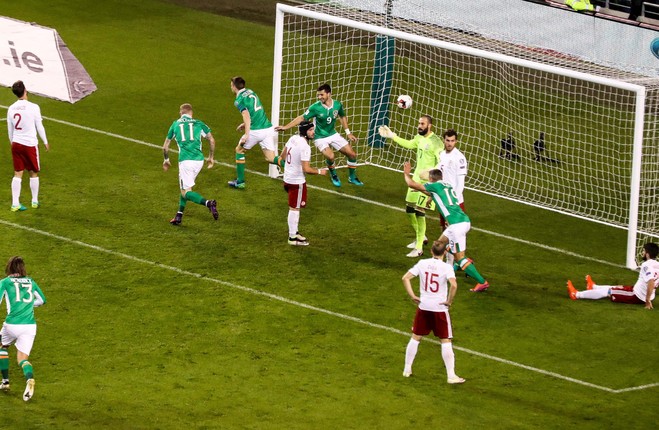WITH ALL THE talk about DNA in football lately, perhaps Ireland’s scrappy win over Georgia would be better analysed by the boffins of genetic science rather than the humble football pundit.
For sure, it was difficult for us non-PHDs to determine any pattern of play or structure to the game. Hell, the Human Genome Project was more straightforward than figuring out how Ireland made such hard work of beating the 137th ranked team in world football.
The big disappointment of this embryonic qualifying campaign has been the failure, so far, to build on the performances against Italy and France at the Euros. Those games, rather than providing a springboard for a new era of aggression and construction, style and steel, now feel like a hazy memory, a summer fling cooled by autumn’s first chill.
The win over Italy, especially, was seized upon at the time as a template for this Irish team to go on with. This was our DNA, people said, marrying the bite and energy of the Jack Charlton era with the ball-playing smarts of a mythical, cobbled street past.
It was a eureka moment – suddenly it all made sense. This was the Rosetta Stone, the Enigma codes. The lost footballing tribe had the map to the Promised Land.
Or not.
All this DNA business seems to have come from the FA’s England DNA project, a vast construct of corporate bunkum foisted upon the football world in late 2014. This featured reams of stuff about values and culture, designed in the hope that future England players could be engineered like those super strong mice running about in genetics labs.
The blurb about how England would play now that this magical DNA had been deciphered included sentences like:
“England teams aim to intelligently dominate possession selecting the right moments to progress the play and penetrate the opposition.”
In other words, get the ball and score goals. It’s hardly rocket, or for that matter genetic, science.
The England DNA was such a solid blueprint that 18 months after it was launched it spawned the international management career of Sam Allardyce, whose football genetics matched the FA’s plan in the way a gorilla’s genes match those of an octopus.
In this country we’ve been trying to map the genomes too. So you have Richard Dunne on one hand saying that the Irish football DNA is to scrap and battle, to mine the points with sweat and toil.
Then John Giles counters that our DNA is a dusty manuscript from the 1950s and 1960s, unearthed lately by Stephen Kenny’s Dundalk. This document details the guile and skill that mark out what Irish football really is, before the monstrous deformity of the Charlton era was allowed to take hold.
But then we have the puzzling ineffectuality of much of the Georgia game, which featured long spells in which neither of those philosophical blueprints were on display, and all this just months after Lille, and with much of the same personnel. No wonder we’re confused.
The problem with this DNA business is that it provides an easy get-out for struggling football cultures. It tells us that there is a magical formula that, if we can just figure out what it is, will solve all our problems.
This is who we REALLY are, we tell ourselves. We’re not this rabble grappling for points off the likes Georgia, stumbling into tournaments occasionally in spite of ourselves. We are actually a confident, dynamic football nation. It’s in our DNA…somewhere.
Rather than the solid certainties of science, this football DNA stuff smacks of the wishy-washy world of self-help. Awaken the Giant Within. Unleash Your Inner Lion. The Secret. And like with the charlatans of the self-help world, the notion that we can tap into this successful football nation that lies within is a con.
The Human Genome Project was the world’s largest scientific collaboration, taking 13 years to map the variations of the genetic sequences that make us who we are. Getting Ireland to the point where we have players who can comfortably handle the doughty Georgians isn’t quite that complicated a task, but it might well take that long.
The search for a football DNA comes from a crisis of confidence in these islands about why we are not producing world-class players anymore.
There are plenty things being done to try to redress this – in Ireland, a grafting of the Dutch DNA is being tried at youth level – but in truth no-one really knows what the blueprint is. Like the scientists messing about with mice, we are splicing genes here and there in the hope of a breakthrough.
Performances like Ireland produced against Italy at the Euros will happen again, but horrifying genetic mutations like the Georgia game will be part of our DNA for a while yet.


